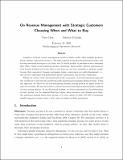Technical Note—On Revenue Management with Strategic Customers Choosing When and What to Buy
Author(s)
Chen, Yiwei; Trichakis, Nikolaos
DownloadAccepted version (232.4Kb)
Open Access Policy
Open Access Policy
Creative Commons Attribution-Noncommercial-Share Alike
Additional downloads
Open Access Policy
Open Access Policy
Creative Commons Attribution-Noncommercial-Share Alike
Terms of use
Metadata
Show full item recordAbstract
© 2020 INFORMS Consider a network revenue management model in which a seller offers multiple products, which consume capacitated resources. The seller uses an anonymous posted-price policy, and arriving customers strategize on (a) when and (b) which product to purchase to maximize their utility, based on heterogeneous product valuations. Such models, whereby customers are both forward looking and choose what to buy, have not yet been amenable to analysis, mainly because their associated dynamic mechanism design counterparts are multidimensional; that is, they involve constraints with multivariate private information (the product valuations). Within the context of the aforementioned model, we present a novel decomposition approach that enables us to deal with the underlying multidimensional mechanism design problem. Using this approach, we derive for all nonanticipating dynamic pricing policies an upper bound to expected revenues. We use our bound to conduct theoretical and numerical performance analyses of static pricing policies. In our theoretical analysis, we derive guarantees for the performance of static pricing, for the classical fluid-type regime where inventory and demand grow large. Our numerical analysis shows static pricing to be able capture at least 75%–90% of maximum possible expected revenue under a wide range of realistic problem parameters.
Date issued
2021Department
Sloan School of ManagementJournal
Operations Research
Publisher
Institute for Operations Research and the Management Sciences (INFORMS)
Citation
Chen, Yiwei and Trichakis, Nikolaos. 2021. "Technical Note—On Revenue Management with Strategic Customers Choosing When and What to Buy." Operations Research, 69 (1).
Version: Author's final manuscript